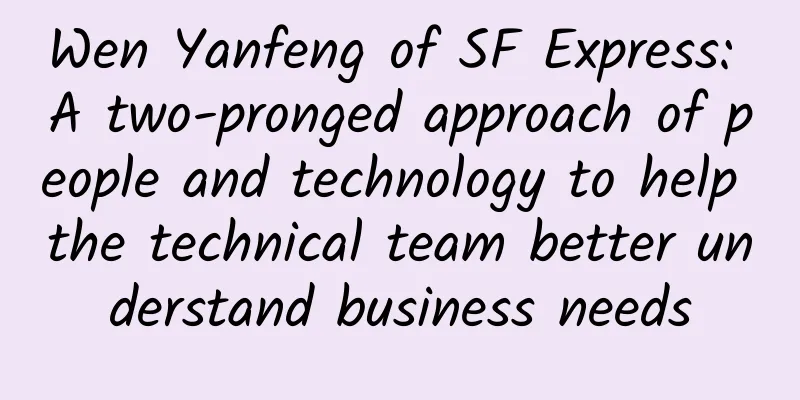Wen Yanfeng of SF Express: A two-pronged approach of people and technology to help the technical team better understand business needs

|
[51CTO.com original article] On December 1st and 2nd, 2017, the WOTD Global Software Development Technology Summit hosted by 51CTO will be held in Shenzhen Zhongzhou Marriott Hotel. The theme of this summit is software development, and dozens of expert guests will bring many wonderful technical content sharing. At that time, Mr. Wen Yanfeng, head of SF Express's platform architecture department, engineering efficiency department, and local project department, will share with guests the keynote speech on "Management and Innovation of Large-scale Logistics Projects" in the "Technical Architecture Meets Business Architecture" special session, and elaborate on the challenges of implementing large-scale logistics systems, as well as the experience sharing of SF Express's software rapid delivery model (SFPD) to effectively deal with these challenges. 51CTO sincerely invites you to attend the conference and share the joy brought by technology with us.
Three special attributes of logistics system Wen Yanfeng introduced that logistics is a field with rich industry characteristics. The characteristics of the logistics system are reflected in three aspects: First, it is a dynamic system. Changes in demand, resources and even the environment will affect its decision-making and behavior. For example, once a traffic accident occurs on a main road, the logistics system needs to adjust the transportation route in time to ensure timeliness. Secondly, it is a very complex system. First, it is complex in terms of objects, with a large variety of materials, sites, and transportation capacity; second, it is complex in terms of people. Effectively managing a ground team of hundreds of thousands is not a simple task. ***, it is a system with a huge span: large spatial span, long time cycle and long process nodes. Wen Yanfeng told reporters that a package may travel thousands of kilometers, take several hours to several days, and be handled by more than a dozen people. "Because of these characteristics, our system architecture must be as strong and stable as the financial system, and as flexible and flexible as the Internet system. This poses a challenge to the technical architecture and business architecture of the logistics system, especially the unification of people and data is particularly important." Wen Yanfeng summarized. Building a harmonious team is inseparable from these keywords In the "Technical Architecture Meets Business Architecture" special session, the communication and collaboration between the business department and the technical department is extremely important but also difficult. Facing this unavoidable problem, Wen Yanfeng was very calm. He believes that the fundamental reason is that technology and business are two teams, not one team, and there are inevitably many information barriers, which leads to deviations in execution. For example, the R&D team only gets a list of requirements, but does not know what the actual pain points are. It may take several iterations to change the pain points; and the business team does not understand which requirements will take a lot of time to change and which requirements will take less time to change, which leads to unreasonable project plans. So how can the two teams fully understand and trust each other and work as a team? Wen Yanfeng also has his own solution. He pointed out that empathy is the first thing. Let R&D personnel and testers leave the cold screen and come to the front line to experience the real problems with the business department; let colleagues in the business department participate in the R&D process as much as possible, such as: demand review, planning scheduling, version release, so that business colleagues can better understand the efforts of R&D colleagues behind a demand. The advantage of doing so is that it will stimulate the vitality of the team, allow good solutions to emerge in an endless stream, and make the team more resilient and stress-resistant; on the other hand, it will also allow the two teams to better understand each other and reduce unnecessary friction. Empathy can make the two teams work hard for a common goal, but without a good rhythm, the passion may be exhausted. Secondly, it needs to be visualized. The R&D team needs to make its capabilities and status transparent, and the business team should also communicate with the R&D team in a timely manner about the goals and actual results to be achieved at each stage, especially the reasons for some direction adjustments, so that both teams have more comprehensive information, so that they can better formulate plans, arrange resources, and achieve goals. In this way, the business team and the R&D team have become a dynamic product team with a strong sense of rhythm. ***, reasonable organizational structure. Whether a production problem or a plan risk can be handled promptly and effectively depends mainly on a clear processing process and a smooth communication mechanism, and an organizational structure with clear responsibilities and rights is the basis of both. SF Software Rapid Delivery Model (SFPD) defines a unified business language and a unified technical language to eliminate communication barriers; it also defines and improves the event handling mechanism and communication mechanism to ensure the smooth progress of the project. SFPD enables SF Express to achieve rapid business delivery Wen Yanfeng also took SF Express as an example to share with reporters the implementation of the SF Express project. It is understood that before the SF Express project is launched, it will be introduced and evaluated in the form of a workshop. During the project, the SF Express Software Rapid Delivery Model (SFPD) is mainly used for project management, process management and quality management. He told reporters that SFPD is based on an iteration cycle for delivery activities. In addition to the characteristics of normal agile development, it also pays special attention to the following three aspects: The first focus is on demand. The number and quality of requirements entering the iteration are crucial to whether the process is smooth and the results are ideal. Demand analysis and review play the role of iteration rectifier. For example, when doing some exploratory, highly uncertain or time-sensitive requirements, you must fully communicate with the business team and reserve time to fix production problems in the next iteration to ensure the stability of the production system and the smoothness of the business. The second focus is the communication mechanism. There are some key nodes in the iteration process, such as requirement review, R&D test, business verification, and the first day of the new version launch. These nodes are more likely to have some events and cause stagnation, so it is necessary to set rules at these nodes to ensure effective information transmission, such as: if R&D cannot test on time, the tester must notify the R&D director; if there are problems that cannot be solved during the test, upgrade every half an hour, etc. The third focus is to solve congestion. Congestion in iterations is basically caused by technical difficulties, resource coordination and external communication. Therefore, SF Software Rapid Delivery Model (SFPD) creatively established a three-in-one R&D engine consisting of agile coaches, project managers and architects. Agile coaches mainly focus on resource coordination and delivery rhythm, architects mainly focus on technical difficulties and architectural risks, and project managers are mainly responsible for integrating information and transmitting effective information internally and externally. In this way, R&D, testing, and operation and maintenance are all focused on delivery, and other matters are handled by these three roles. When they exceed their processing capabilities, they are upgraded and resolved through communication mechanisms. In an interview with ***, Wen Yanfeng also revealed that the concept of smart logistics is now widely known, and more and more sensors are collecting various data into the brain (big data platform, computing platform, etc.) for regularity analysis and decision analysis, and more efficient command of "hands and feet". In his opinion, the future logistics system architecture will pay more attention to communication efficiency, because it is the foundation of everything, and will sink more local decisions to the end for execution; this will further promote the vigorous development of communication technology, machine learning algorithms and computing chips. [51CTO original article, please indicate the original author and source as 51CTO.com when reprinting on partner sites] |
<<: Discussion on SD-WAN and IP Network Evolution
Recommend
Without IPv6, there is no future. Let’s talk about the necessity of deploying IPv6.
The first large-scale IPv6 transformation was in ...
WiFi passwords are always cracked? Here are some tips to help you avoid WiFi hacks
With the development of mobile Internet technolog...
What does the all-out war on IPv6 mean for China's Internet?
[[238041]] Image source: Visual China IPv4. What ...
Detailed interpretation of the report: Know the current status of global 6G development in one article
[[396055]] Recently, the Intellectual Property De...
It’s finally here! The first 5G international standard is officially completed and frozen
Recently, the formulation of 5G (fifth-generation...
OlinkCloud: $5.6/month KVM-1GB/10G SSD/500GB/San Jose
Tribe shared the news about Olink.Cloud in Novemb...
Do you know the misunderstandings about 5G?
Today I will reveal to you five misunderstandings...
RAKsmart: Cloud servers starting from $1.99/month, VPS hosting starting from $0.99/month, data centers in Hong Kong/Japan/Singapore/Korea/USA
RAKsmart is a hosting company founded by overseas...
Weak current people must understand standard PoE power supply! Otherwise, if you don't understand the IPC power supply power and line sequence, how can you do a good project?
What is Standard PoE? PoE, or Power over Ethernet...
Wi-Fi 6 is not yet popular, so why has the latecomer Wi-Fi 7 become a battlefield for giants?
When it comes to Wi-Fi, everyone is familiar with...
The intelligent world is waiting for you to build. Huawei Cloud joins hands with millions of developers to Login 2020
What does an intelligent world where everything i...
[6.18] edgeNAT 40% off on all VPS annual payments, starting at 360 yuan for annual payments in Hong Kong/Korea/US data centers
edgeNAT is a Chinese hosting company established ...
5G CPE replaces fiber-to-the-home, and demand is booming in Europe, America and rural areas
2019 is known as the first year of 5G. In fact, s...
UBBF2020: Intelligent connectivity, creating new growth in industry value
[Beijing, China, October 13, 2020] Today, the 6th...
Cisco releases new developer capabilities for intent-based networking platform
Cisco today announced new developer capabilities ...
![[6.18] LOCVPS 20% off, top up 100 get 10 yuan / top up 5000 get 618 yuan, 4G memory package starts from 52 yuan/month](/upload/images/67cabe8b75a0f.webp)








